To integrate VB.NET (or any .NET language) with Flutter, you typically follow a client-server architecture. VB.NET can be used on the server side to handle business logic and data processing, while Flutter can be used to build the client-side user interface.
Here’s a high-level guide on how you might approach this integration:
Server-Side (VB.NET):
- Create a VB.NET Web API:
- Use a framework like ASP.NET Core to create a RESTful Web API. You can use Visual Studio to create a new project with the “ASP.NET Core Web Application” template.
- Implement your business logic and data processing within the Web API controllers.
- Expose Endpoints:
- Expose endpoints in your Web API to perform various operations. These endpoints will handle requests from the Flutter app.
- Secure Endpoints (Optional):
- Implement authentication and authorization mechanisms if needed. You may use token-based authentication, JWT, or other methods to secure your API.
- Test the API:
- Test your API using tools like Postman to ensure that it works as expected.
Client-Side (Flutter):
- Create a Flutter Project:
- Use the Flutter SDK to create a new Flutter project using the
flutter createcommand.
- Integrate HTTP Requests:
- Use the
httppackage in Flutter to make HTTP requests to your VB.NET Web API. You can add this package to yourpubspec.yamlfile:dependencies: http: ^0.14.0 - Run
flutter pub getto fetch the package.
- Make API Requests:
- Use the
httppackage to make requests to the endpoints exposed by your VB.NET Web API.import 'package:http/http.dart' as http; Future<void> fetchData() async { final response = await http.get('http://your-api-endpoint'); // Process the response }
- Handle Responses:
- Parse and handle the responses from the VB.NET Web API in your Flutter app.
Testing:
- Run Both Projects:
- Run your VB.NET Web API project on a server.
- Run your Flutter app on an emulator or a physical device.
- Test Communication:
- Test the communication between the Flutter app and the VB.NET Web API by triggering API requests from your Flutter app.
Deployment:
- Deploy VB.NET Web API:
- Deploy your VB.NET Web API to a server or a cloud platform.
- Distribute Flutter App:
- Distribute your Flutter app through app stores or other distribution channels.
Important Note:
- Ensure that the server hosting your VB.NET Web API allows incoming connections from your Flutter app. Handle security aspects such as HTTPS, secure authentication, and authorization.
This is a high-level overview, and the specifics may vary based on your project requirements and architecture.
